Stand Up Paddling has many positive effects on your health and, regarding the question, ‘Is SUP Good for your back’, the short answer is:
Yes, it is proven that SUP is one of the ideal sports for those experiencing back pain. A study by the Health Policy Institute of Georgetown University Medical research shows that about 8% of people experience lower back pain. We experience back pain for various reasons, and the common cause is stiff or weak muscles in this region. As Stand Up Paddling is a low-impact training and requires constant stabilization of the body, it not only trains the back muscles gently but also trains the so-called deep or core muscles which are often the cause of back pain. Here we show you in detail how and why SUP is an efficient way to get rid of these problems.
Paddling is a great low-impact sport that involves activities that effectively reach the lower back region. It provides the ideal way to work out while enjoying cruising through still and silent water currents. Below are answers to some vital questions regarding SUP and its effect on a person’s back.
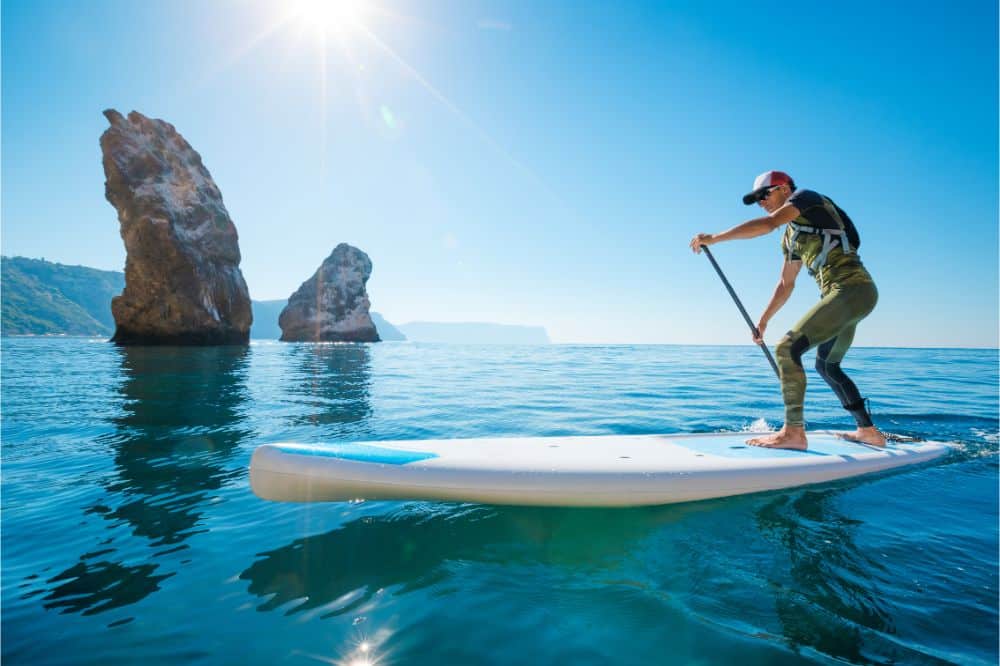
Why SUP Is Good For Your Back
Paddling can help eliminate back pain since it involves bending and twisting activities that don’t exert more on your back. The good thing about the sport is that it has no age limit and even seniors can engage in it.
To answer your question, paddling suits your back, and also for those not suffering from back issues. The sport engages almost all body muscles and it strengthens the core and back muscles in the process. Here are some reasons why SUP is great for strengthening your back:
It Is A Low-Impact And Joint-Friendly Sport
Paddling is a whole-body workout that involves the back and other parts. This sport helps the back build strength and endurance but doesn’t overstress it. As you navigate and explore still water, the back region becomes sturdy and gains balance.
It Promotes Balance-Building
SUP requires the body to generate the right balance with all the various muscle groups coordinating together. These movements work and train these muscles, especially the deep or core muscles. The deep muscles are what assure stability among vertebrates and are often the cause of back pain. It is important to know that especially those muscles are harder to train in exercises that do not include coordination and body stabilization.
Furthermore, SUP has some great advantages for elderly people. Seniors find it hard to maintain an active lifestyle essential for healthy living. Yet, as one paddle on exciting trails, the back works in coordination with other body organs and rebuilds strength for these aging bodies.
SUP also works its magic and trains the larger muscle groups such as latissimus and trapezius.
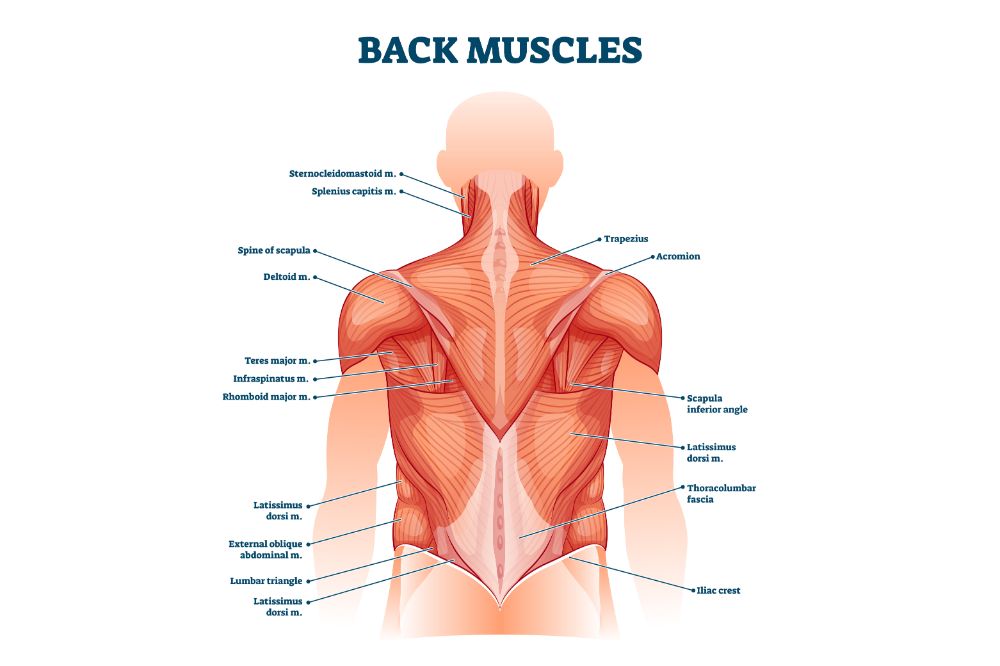
Picture from Europosters.de(Please check for an according picture which is allowed to use)
Therefore, if you wish to build a strong and pain-free back, SUP is the way to go. The paddling activities promote balance building without overstressing the delicate muscles.
Is SUP A Cure For All Back Pain Problems?
SUP is not a cure for all back pain problems, but it is a low-impact sport that strengthens the back muscles. In addition, its gentle nature makes it ideal for back pain since it exerts less pressure on the region than other workout programs.
This sport engages the entire body and proves helpful, especially to lower back pain patients. The activities involved, such as bending and twisting, strengthens the weak muscles causing the pain. However, most of these conditions are minor and SUP quickly remedies that.
It is, however, a concern if your lower back pain becomes too much or persists. This is an indication that there’s a need to become examined by a qualified and licensed doctor. The doctor will then prescribe medication or, in extreme cases, schedule surgery.
Therefore, do not expect SUP to fix all your back pain problems. It is also advisable to consult a doctor before doing so to understand the extent of the situation. Speak to a doctor to avoid worsening the situation by indulging in this sporting activity.
Is SUP Good For Your Sciatica?
Sciatica is a severe pain caused by compression of the sciatic nerve that branches from the lower back to the hips.
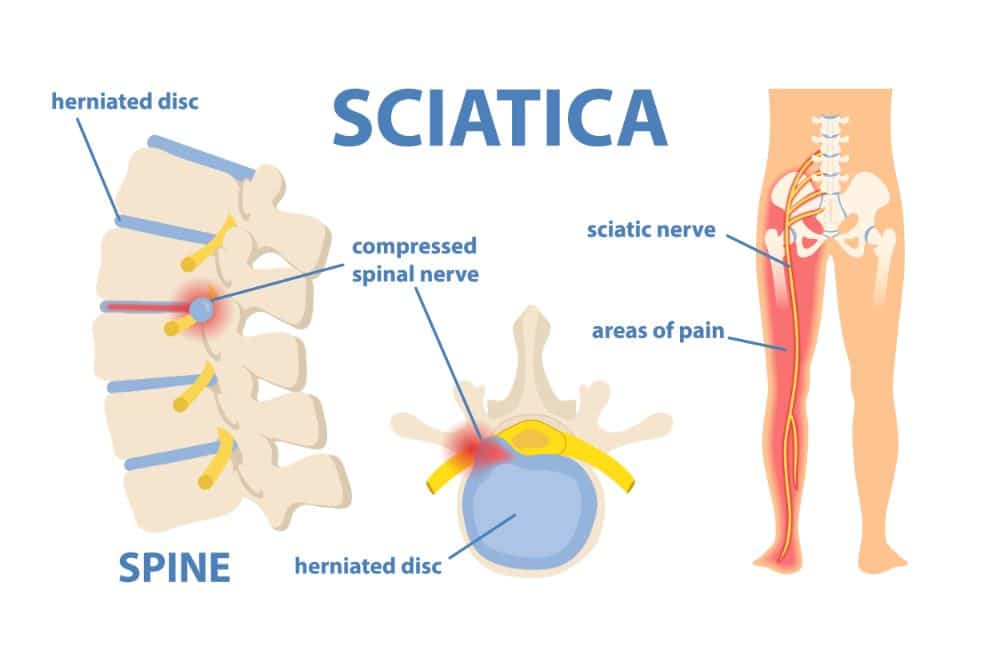
Exercise and physiotherapy are the first-time treatments for treating, relieving, and preventing sciatica symptoms, especially activities focusing on the lower back, hip, and leg region. SUP is a sport that focuses on these areas and therefore provides higher chances of providing symptom relief, promoting healing, and preventing future recurrences.
But is SUP now Good for the Sciatia?
As Stand Up Paddling engages all the associated muscles in the back, hip, and buttocks, and helps with Sciatica. These activities strengthen and mobilize tissues in these regions, promoting faster recovery. It is, however, vital to consult a physician to understand what areas to stress and the activities to avoid.
For SUP to be an effective mode of treating Sciatica, one must be committed and eager to go out and paddle away. This treatment option involves exercise; you can’t expect to get better with one session. However, consistent dedication makes the nerve align perfectly and creates stronger muscles.
Can SUP Also Cause Back Pain?
SUP can cause back pain if not done correctly. The potential damage is, however, smaller since it is less complicated or demanding. However, it is important to consult experts and learn the correct way of doing things.
This is the case for SUP, just like any other sport where there are chances of becoming injured. Engaging in the sport without knowing the essentials, such as the paddle length and pose, can be bad news to your back. Instead of relieving back pain, wrong techniques can do more harm than good.
For example, if you do not know how to stand correctly on the board. This means that throughout the paddling session, there is an imbalance and one side is getting more pressure than the other. More pressure on injured or weak muscles might extend the situation, leading to more severe pain.
That is why it is not a good idea for beginners, especially older citizens, to study our Tips and Advice section thoroughly if they lack the required skill set yet, as all the essential and important aspects of the paddling technique are explained in detail. And there is no need to be concerned: The correct SUP Technique is easy to learn. We show you the most important aspects below in this article. More detailed information can be found in our Tips and Advice Section, which covers everything you need to know.
The most important aspects of the SUP Technique for your back
Paddling in the wrong posture for too long strains the lower back muscles and increases pain. Understanding the correct SUP technique is essential to prevent unwanted twisting and movements. These helpful tips include:
Standing On The Paddle Board Correctly
Standing loosely on a paddleboard increases the risk of getting pushed lightly from behind without warning. That is why it is essential to slightly bend your knees and have the upper body upright in all paddling stances. In addition, it is best to learn the ideal standing posture to prevent inconveniences on the way.
Before determining the ideal standing position while paddling, we must understand the following stances: the parallel, staggered, and surf stance. There is no ideal standing and you’ll be required to switch through these options to maintain an excellent sliding position.
There’s more to learn about standing on the board correctly and that’s why it is best to check out How to Stand Up Paddle Board: Standing Positions and everything about the SUP Paddle Technique – Cool Water Sports for more information. However, here are some basics about some of the popular paddling positions.
The Parallel Stance
This position requires the legs to be about shoulder-width apart from the sweet spot. The sweet spot is approximately the center of gravity of the board and is usually marked on most paddleboards. A parallel stance is the best way to begin paddling, especially when moving straight ahead.
The Staggered Stance
The parallel stance is the primary paddling position, but it can be uncomfortable, especially during long adventures. This is mainly because of the less dynamic positioning of the feet. If this becomes the case, feel free to switch to the staggered stance where you have one foot in front of the sweet spot and the other slightly behind the sweet spot.
A pro tip is to have the rear foot be the side you are paddling and the feet tips should point slightly towards the paddle. Remember to do the same if you opt to switch the paddling side.
The Surf Stance
Paddling in shallow waters is the ideal spot for beginners and it is incredible how they quickly learn how to maneuver around. The surf stance is a simple posture that makes it easier to maintain stability when negotiating a fast corner or circumnavigating a buoy.
This posture requires the feet to point in the direction of travel. The left foot is then placed in front in a natural stance or the right foot, also known as the goofy stance. There is no specific way and you are the one to determine which foot should be placed at the front.
How To Hold The Paddle Correctly
The right way to hold any SUP paddle is in a way that the angle between the blade and shaft is in the direction of travel. This technique helps increase the pulling distance and the paddle’s efficiency. It is incredible how much power and energy one saves by correctly holding the paddle.
Paddling at this angle ensures the blade stays perpendicular to the water surface. In addition, this angle requires less effort to navigate, even through harsh currents.
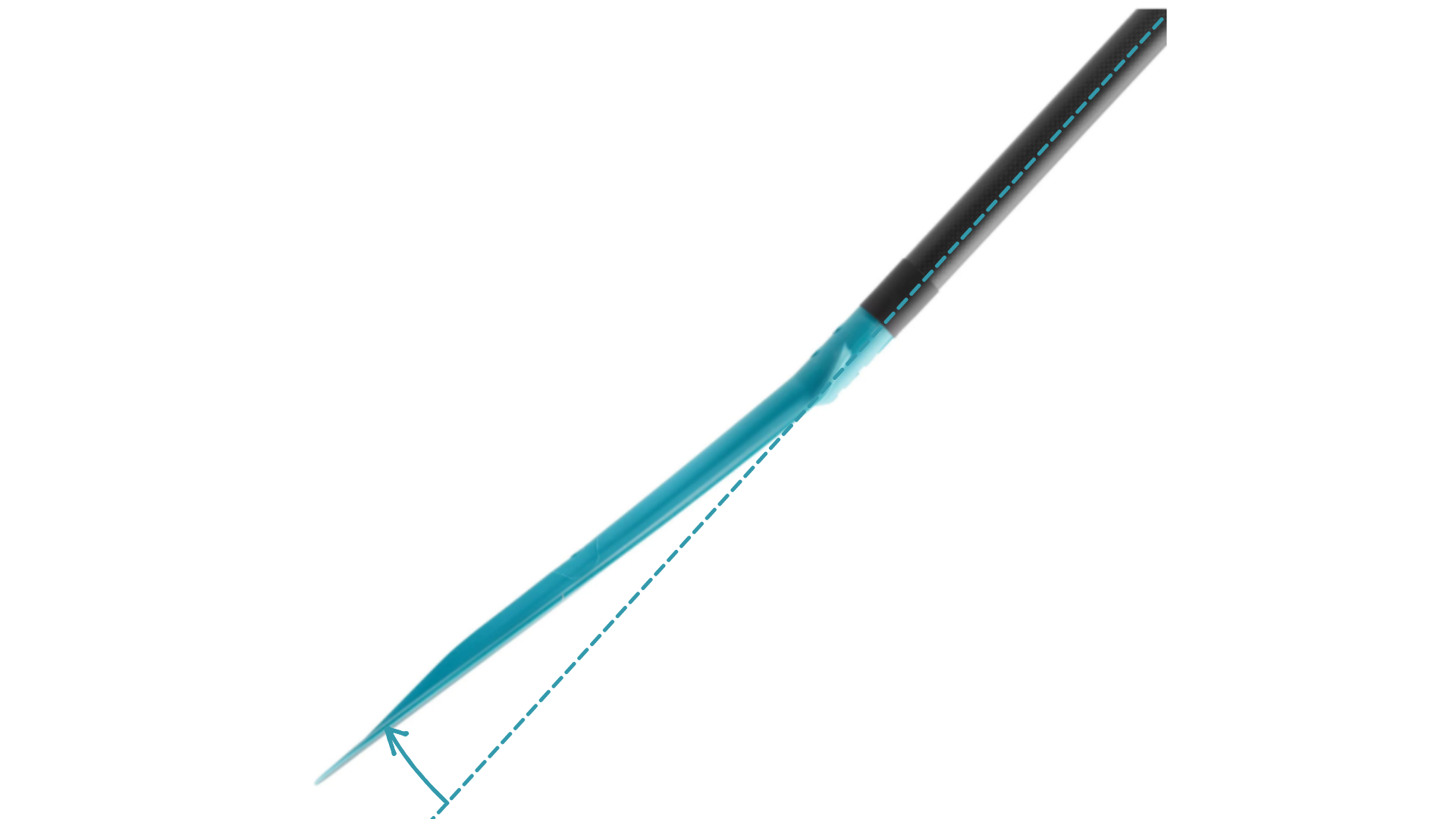
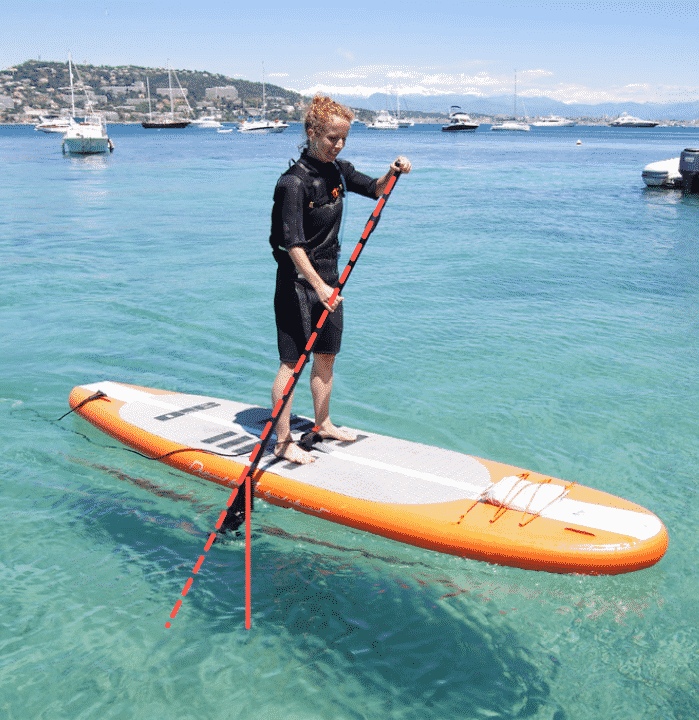
The Right Paddle Length
The length of the paddle is a crucial aspect to consider before going on an adventure. One of the best ways to determine the right paddle length is to place the upright paddle position, with the handle touching the floor. Your ideal paddle is one in which the shaft rests at eye level.
Another quick way to determine the correct length is through numbers. A wave SUP paddle is about 5 to 10 cm shorter, and a standard SUP paddle for beginners is usually 10 to 15 cm shorter. The best way is to get an adjustable paddle that allows you to test it out and determine the ideal length.
The Ideal Arm Posture
The best way to hold your paddle is to hold it loosely with relaxed wrists. This ensures enough grip force is generated, giving you more than enough control of the paddle. In addition, most SUP techniques require you to stretch out the arms into a position that enables you to paddle with the stronger core muscles, not the weak groups on the arm and shoulders.
Getting an optimal grip width is vital if you wish to generate the correct paddle stroke. The best way to determine this width is through the box trick, where the paddle is held horizontally over the head and forms a rectangle between the paddle and arms. This then gives the ideal position for optimal grip range.
SUP Paddle Technique – How To Paddle Properly
After learning the three basic paddling stances, it is essential to coordinate your body and paddle correctly. Everyone can paddle; however, it becomes easier to learn it the right way if one follows these tips:
The Ideal Paddle Stroke
Five primary stroke phases include the starting position, catch, power, exit, and recovery.
● The starting position ensures you generate reach comfortably. However, it requires one to stretch out the shaft hand and bend the upper body slightly forward.
● The catch phase requires you to immerse the paddle blade completely. This is achieved by keeping the upper body straight and moving back and forth. The stance allows slight body movements around the hips and legs. Especially regarding your back, it is important to keep it straight during the starting and the catch phase. It is important that during those phases, your body and your paddle form an A.
● The power phase is when you paddle with the arms more or less stretched out to use the larger muscles to generate power. This correct posture requires one to straighten the body and generate force by rotating the body in synchronized motion. The paddle shaft should also be vertical. This means that you bend your hip from the front slightly. The force during the pull does not come from bending your arm but from rotating your torso. So try to keep your arms more or less stretched during the whole power stroke.
● The main goal of attempting the exit technique is to paddle out of the water with less resistance, which happens when the paddle reaches heel height. This process involves turning the paddle blade away from the board using your top hand. Next, bend the arm of the shaft hand and guide it to the front of the hip to push the paddle sideways and down.
● The recovery phase involves bringing the paddle out using a flowing rotation, with the body and top hand facing towards the bow. Conduct simultaneous body and hand rotations to position the paddle in the proper starting position automatically.
A pro tip is always to stand with the knees bent at the sweet spot. In addition, you should always look straight ahead and not on the board. The third tip is if you choose to paddle on the left side, ensure the left hand is the one holding the paddle at the bottom.
Beginners should take their first paddling lessons in calm water and weather with less wind. As much as it is fun being propelled through currents with the winds, it is challenging to navigate against a headwind.
The best way to grasp these basics is to practice often to perfect the art. You can also watch the SUP Paddle Technique: How to paddle properly on a SUP full video tutorial that shows how to correctly execute the different phases with ease.
Conclusion
SUP comprises low-impact, fun activities that help strengthen back muscles and prevent back pain. There are instances where this sporting activity relieves the pain; however, it needs to be done correctly. Most physicians and doctors recommend SUP as a great natural therapy for those suffering from mild Sciatica and lower back pain. This review is the perfect guide for this recovery journey as it addresses the main SUP concerns and gives insight into how to paddle correctly.
Paddling offers more than physical therapy for the back. It is an activity that engages the budo muscles responsible for stability. However, you have to always use the right paddle techniques to reap these benefits, and you can find all tutorials on how to paddle correctly at coolwatersports.






